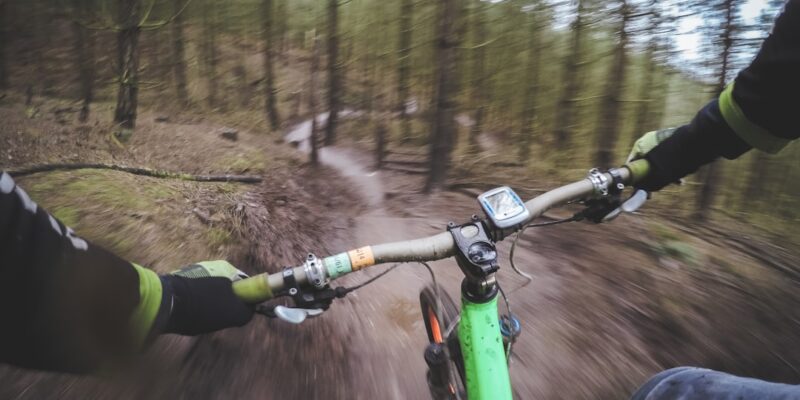
Exploring Rockies’ Epic Mountain Biking Trails
The Rocky Mountains are a haven for outdoor enthusiasts, and mountain biking is no exception. With its rugged terrain, breathtaking scenery, and extensive trail network, the Rockies offer some of the best mountain biking experiences in the world. From beginner-friendly trails to adrenaline-pumping downhill descents, there is something for every level of rider.
The Rockies’ mountain biking scene has gained popularity over the years, attracting riders from all over the world. The region offers a diverse range of trails, from smooth and flowy singletracks to technical and challenging downhill runs. Whether you’re a seasoned rider looking for a new challenge or a beginner looking to improve your skills, the Rockies have it all.
Key Takeaways
- The Rockies offer some of the best mountain biking trails in the world.
- The best time to explore these trails is during the summer months.
- The top 5 must-visit trails include the Colorado Trail, Monarch Crest Trail, 401 Trail, Kenosha Pass Trail, and the Whole Enchilada Trail.
- Proper preparation, including bike maintenance and safety gear, is crucial for a successful Rocky Mountain biking adventure.
- Dos and don’ts of mountain biking in the Rockies include respecting wildlife, staying on designated trails, and being aware of weather conditions.
The Best Time to Explore the Rockies’ Epic Mountain Biking Trails
The Rockies experience four distinct seasons: spring, summer, fall, and winter. Each season offers a unique experience for mountain biking, so it’s important to choose the right time to visit.
Spring is a great time to explore the Rockies’ mountain biking trails as the snow begins to melt and the trails start to dry out. The weather can be unpredictable during this time, with occasional rain showers and cooler temperatures. However, the trails are less crowded, and you’ll have the opportunity to see wildflowers in bloom.
Summer is the peak season for mountain biking in the Rockies. The weather is warm and dry, making it ideal for riding. The trails are in their best condition during this time, and you’ll have access to a wide range of trails suitable for all skill levels.
Fall is another great time to visit the Rockies for mountain biking. The weather is cooler, and the foliage starts to change colors, creating a stunning backdrop for your rides. The trails are less crowded compared to summer, allowing you to enjoy a more peaceful experience.
Winter is not typically recommended for mountain biking in the Rockies unless you’re an experienced fat biker. The trails are covered in snow, and the conditions can be challenging. However, if you’re up for the challenge, fat biking can be a thrilling way to explore the Rockies during the winter months.
Top 5 Must-Visit Mountain Biking Trails in the Rockies
1. The Whole Enchilada – Moab, Utah
The Whole Enchilada is a legendary trail located in Moab, Utah, just outside the Rockies. It offers a challenging and technical ride with stunning views of the surrounding red rock landscape. The trail starts at an elevation of over 10,000 feet and descends through various terrains, including alpine meadows, aspen groves, and slickrock sections. It’s a long and demanding ride, but the reward is well worth it.
2. Monarch Crest Trail – Salida, Colorado
The Monarch Crest Trail is a classic Colorado ride that offers breathtaking views of the Sawatch and Sangre de Cristo mountain ranges. The trail starts at an elevation of over 11,000 feet and follows a ridgeline for most of its length. It’s a high-altitude ride with technical sections and long descents. The trail can be done as a point-to-point ride or as a loop, depending on your preference.
3. Trestle Bike Park – Winter Park, Colorado
Trestle Bike Park is a downhill mountain biking paradise located in Winter Park, Colorado. It offers over 40 miles of lift-served trails with various difficulty levels, from beginner-friendly flow trails to expert-level jump lines. The park has something for everyone, whether you’re a seasoned rider looking for big jumps or a beginner looking to improve your skills.
4. Galbraith Mountain – Bellingham, Washington
Galbraith Mountain is a popular mountain biking destination located in Bellingham, Washington, just outside the Rockies. It offers over 65 miles of trails with a mix of flowy singletracks, technical descents, and challenging climbs. The trails are well-maintained and offer stunning views of the surrounding mountains and forests.
5. Kingdom Trails – East Burke, Vermont
Kingdom Trails is a world-class mountain biking destination located in East Burke, Vermont. It offers over 100 miles of trails that wind through the picturesque Northeast Kingdom region. The trails range from easy and scenic to technical and challenging, catering to riders of all skill levels. The area is known for its beautiful fall foliage, making it a popular destination in the fall.
How to Prepare for Your Rocky Mountain Biking Adventure
| Topic | Metric |
|---|---|
| Physical Preparation | Cardiovascular endurance training |
| Strength training for legs and core | |
| Gear | Mountain bike with appropriate tires and suspension |
| Helmet and protective gear | |
| Navigation | Trail maps and GPS device |
| Compass and backup navigation tools | |
| Hydration and Nutrition | Water bottles or hydration pack |
| Energy bars and snacks | |
| Emergency Preparedness | First aid kit |
| Emergency whistle and signaling device |
Before embarking on your Rocky Mountain biking adventure, it’s important to prepare yourself physically, gather the necessary gear and equipment, and plan your route.
Physical preparation is key to enjoying your mountain biking experience in the Rockies. Start by incorporating regular cardio and strength training exercises into your routine to build endurance and strength. Focus on exercises that target your legs, core, and upper body to improve your overall fitness for mountain biking.
In terms of gear and equipment, a good-quality mountain bike is essential. Choose a bike that is suitable for the terrain you’ll be riding on, whether it’s a full-suspension bike for technical descents or a hardtail for smoother trails. Don’t forget to wear a helmet and protective gear such as knee pads and elbow pads to ensure your safety on the trails.
Planning your route is crucial to make the most of your Rocky Mountain biking adventure. Research the different trails in the area you’ll be visiting and choose ones that match your skill level and preferences. Consider factors such as trail difficulty, distance, elevation gain, and scenery when planning your route. It’s also a good idea to check trail conditions and weather forecasts before heading out.
The Dos and Don’ts of Mountain Biking in the Rockies
When mountain biking in the Rockies, it’s important to follow trail etiquette, prioritize safety, and minimize your environmental impact.
Trail etiquette is crucial to ensure a positive experience for all trail users. Yield to uphill riders and hikers, and slow down or stop when passing other riders. Stay on designated trails and avoid creating new ones to protect the natural environment. Leave no trace by packing out your trash and avoiding littering.
Safety should be your top priority when mountain biking in the Rockies. Always wear a helmet and protective gear, and ride within your skill level. Carry a first aid kit and know basic first aid procedures in case of an emergency. Be aware of your surroundings and watch out for wildlife, especially in areas where encounters are common.
Minimizing your environmental impact is essential to preserve the natural beauty of the Rockies. Stay on designated trails to avoid damaging vegetation and wildlife habitats. Avoid riding on wet or muddy trails to prevent erosion. Pack out your trash and dispose of it properly. Respect wildlife by observing from a distance and not feeding or approaching them.
How to Choose the Right Mountain Bike for the Rockies’ Terrain
Choosing the right mountain bike for the Rockies’ terrain is crucial to ensure a comfortable and enjoyable ride. There are several types of bikes suitable for different types of terrain, including cross-country bikes, trail bikes, enduro bikes, and downhill bikes.
Cross-country bikes are lightweight and efficient, making them ideal for long rides with lots of climbing. They have less suspension travel compared to other types of bikes, making them better suited for smoother trails.
Trail bikes are versatile and can handle a wide range of terrain. They have more suspension travel than cross-country bikes, making them suitable for technical descents while still being efficient on climbs.
Enduro bikes are designed for aggressive riding and can handle rough and technical terrain. They have more suspension travel than trail bikes, making them better suited for challenging descents.
Downhill bikes are specifically designed for downhill racing and can handle the most challenging terrain. They have the most suspension travel and are built to withstand high speeds and big jumps.
When choosing a mountain bike for the Rockies, consider factors such as the type of terrain you’ll be riding on, your skill level, and your riding style. Test ride different bikes to find one that feels comfortable and suits your needs.
Safety Tips for Mountain Biking in the Rockies
Mountain biking in the Rockies can be an exhilarating experience, but it’s important to prioritize safety. Here are some safety tips to keep in mind:
– Always wear a helmet and protective gear, including knee pads, elbow pads, and gloves.
– Ride within your skill level and avoid attempting trails that are beyond your abilities.
– Carry a first aid kit and know basic first aid procedures.
– Be aware of your surroundings and watch out for wildlife. Give them plenty of space and do not approach or feed them.
– Ride with a buddy or let someone know your planned route and estimated return time.
– Carry a map, compass, or GPS device to navigate the trails.
– Stay hydrated and carry enough water and snacks for your ride.
– Be prepared for changing weather conditions by carrying extra layers of clothing and rain gear.
– If you encounter a technical section or obstacle that you’re not comfortable with, dismount and walk your bike.
The Best Accommodations for Mountain Bikers in the Rockies
When planning your Rocky Mountain biking adventure, it’s important to choose accommodations that cater to mountain bikers. Here are some options to consider:
Campgrounds and RV parks: There are numerous campgrounds and RV parks located near popular mountain biking trails in the Rockies. These accommodations offer amenities such as showers, restrooms, and picnic areas, making them convenient for outdoor enthusiasts.
Lodges and hotels: If you prefer a more comfortable stay, there are lodges and hotels located in or near mountain biking destinations in the Rockies. These accommodations offer amenities such as comfortable beds, hot showers, and on-site restaurants.
Bike-friendly accommodations: Some accommodations in the Rockies cater specifically to mountain bikers. These accommodations offer amenities such as bike storage, bike wash stations, and repair facilities. They may also offer guided rides or have trail maps available for guests.
When choosing accommodations, consider factors such as proximity to the trails, amenities offered, and budget. It’s also a good idea to book in advance, especially during peak season.
Other Outdoor Activities to Enjoy in the Rockies
In addition to mountain biking, the Rockies offer a wide range of outdoor activities for adventure enthusiasts. Here are some activities to consider:
Hiking: The Rockies are home to numerous hiking trails that offer stunning views of mountains, lakes, and forests. Whether you’re looking for a leisurely stroll or a challenging hike, there is a trail for every level of hiker.
Fishing: The Rockies are known for their pristine rivers, lakes, and streams, making it a paradise for fishing enthusiasts. Cast your line and try your luck at catching trout, salmon, or other freshwater fish.
Rafting: If you’re looking for an adrenaline rush, consider going whitewater rafting in the Rockies. Experience the thrill of navigating through rapids while enjoying the beautiful scenery along the way.
These are just a few examples of the many outdoor activities available in the Rockies. Whether you’re looking for a relaxing day by the lake or an adrenaline-pumping adventure, there is something for everyone in this outdoor playground.
Why the Rockies’ Epic Mountain Biking Trails are a Must-Visit for Adventure Enthusiasts
The Rockies’ epic mountain biking trails offer an unforgettable experience for adventure enthusiasts. With its diverse terrain, stunning scenery, and extensive trail network, the Rockies are a dream destination for mountain bikers of all skill levels.
From the challenging technical descents of Moab to the flowy singletracks of Kingdom Trails, there is a trail for every type of rider in the Rockies. The region’s four distinct seasons offer unique experiences throughout the year, whether you’re riding through wildflowers in the spring or enjoying the fall foliage in the autumn.
To make the most of your Rocky Mountain biking adventure, it’s important to prepare physically, gather the necessary gear and equipment, and plan your route. Follow trail etiquette, prioritize safety, and minimize your environmental impact to ensure a positive experience for yourself and others.
Whether you’re a seasoned rider or a beginner looking to improve your skills, the Rockies’ epic mountain biking trails are a must-visit destination. So grab your bike, hit the trails, and get ready for an adventure of a lifetime in the heart of the Rockies.
FAQs
What are mountain biking trails?
Mountain biking trails are paths or routes designed for mountain bikers to ride on. These trails can vary in difficulty and terrain, and are often located in natural areas such as forests, mountains, and parks.
Where are the Rockies?
The Rockies, also known as the Rocky Mountains, are a mountain range located in western North America. They stretch from British Columbia in Canada to New Mexico in the United States.
What are some popular mountain biking trails in the Rockies?
Some popular mountain biking trails in the Rockies include the Colorado Trail, the Monarch Crest Trail, the 401 Trail in Crested Butte, and the Whitefish Trail in Montana.
What is the difficulty level of mountain biking trails in the Rockies?
The difficulty level of mountain biking trails in the Rockies can vary from beginner to advanced. Some trails are designed for families and beginners, while others are more technical and require advanced skills.
What should I bring when mountain biking in the Rockies?
When mountain biking in the Rockies, it is important to bring appropriate gear such as a helmet, gloves, and protective eyewear. It is also recommended to bring plenty of water, snacks, and a first aid kit.
Are there any rules or regulations for mountain biking in the Rockies?
Yes, there are rules and regulations for mountain biking in the Rockies. These can vary depending on the specific trail and location, but common rules include staying on designated trails, yielding to hikers and equestrians, and respecting wildlife and natural resources.


















